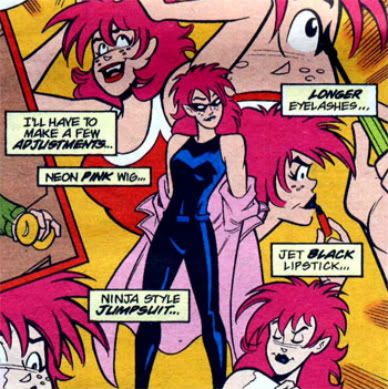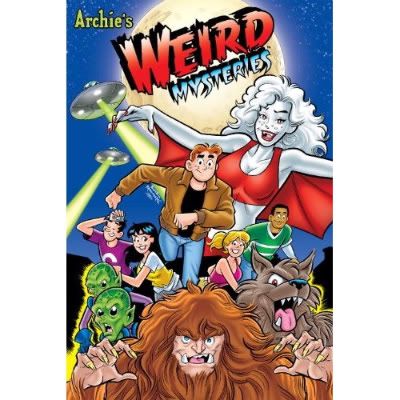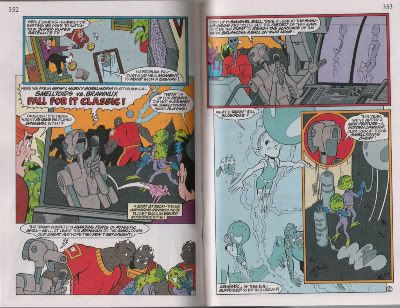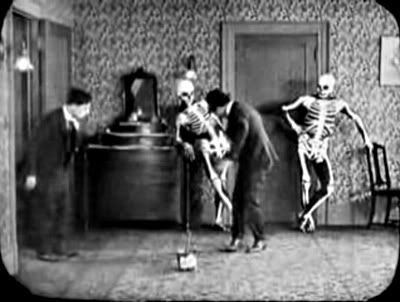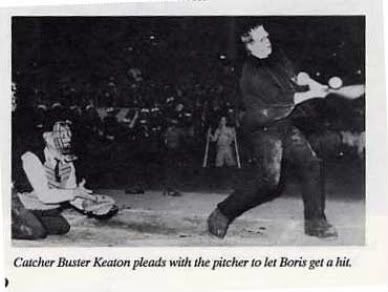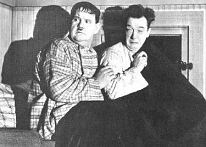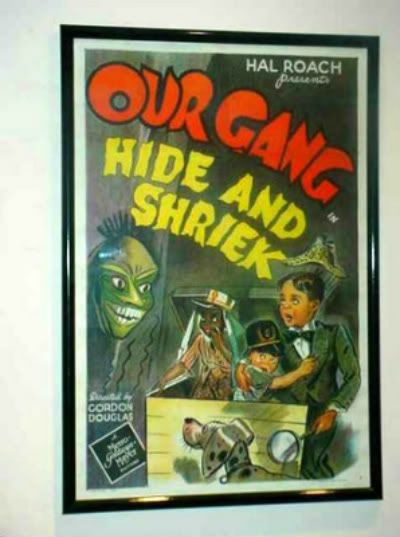
** & ½ out of ****
PLOT: Alfalfa has launched a detective agency and appointed Porky and Buckwheat as deputies. Darla brings the intrepid trio their first case: they must find her missing candy. While stowing away in the trunk of a vehicle to tail their prime suspect, the kids are transported to a “horror house” amusement attraction that they think is real, complete with scary voices, images and monster figures that leap out at the gang! Can these little rascals solve the case even though they’re scared silly?!
REVIEW: I am a huge fan of Leonard Maltin. I admire him greatly for his determination to give proper scholarly due to genre films and the folks that made them at a time when cinema cognoscenti at large deemed them unworthy of such analysis. Perhaps it was the fact that he was only 15 when he began writing for the Classic Images tabloid and starting his own fanzine, Film Fan Monthly that he was able to so casually deflect the stuffy critics’ objections like a spitball feebly bouncing off a corkboard. After all, when you’re young your world is young, and it really doesn’t matter what old, snobbish codgers say, right?
Leonard went on to pen many books that I’ve devoured over the years, beginning with my own youth borrowing his works from a northern New Jersey library. His books helped shaped me – not just my love of classic genre films but also as a fellow writer and historian. I can’t count the times in my own career when I turned a phrase and upon review, realized how “Maltinesque” it was!
Among my favorite Maltin books are “Movie Comedy Teams,” “The Great Movie Comedians,” “The Great Movie Shorts” (aka “Selected Short Subjects”) and “Of Mice & Magic: a History of American Animated Cartoons.” Books on all these subjects have been written since, some quite good but for me the Maltin books always top their competitors, due to the sheer love and verve for his subject matters that Maltin pores into every page as well as the diligent research. To this day, Maltin has written what I consider to be the definitive book on the Our Gang (aka Little Rascals) shorts, “Our Gang: the Life and Times of The Little Rascals.”
In Leonard Maltin’s wonderful “Our Gang” book, he notes that the final entry in a film series is frequently “assembled hastily, with little care” to fulfill a contract and move on and that “Hide and Shriek,” the final “Our Gang” short to be produced at Hal Roach Studios before MGM took over the series is the “exception to that rule.” Further, he states that “it offers some fresh story slants” and that by being a spoof it “really doesn’t matter that its haunted house scenes give off a definite air of contrivance.”
I love Leonard Maltin and agree with him most of the time, but my reaction to this particular short leaves me in disagreement with him this time. “Hide and Shriek” is enjoyable inasmuch as it’s the last go-round for the kids at Roach, but there are a few things missing.
It’s almost as if the Roach crew just said, “this is the last one, let’s make this as easy as possible – kids getting scared – that’s the easiest ‘plot’ there is – and we can shoot on location at the local carnival funhouse.”
On top of that, they didn’t even have a complete cast of kids to work with. Either they were off on summer vacations or the studio just felt it wasn’t worth all the paychecks. The film is left to rest squarely on the shoulders of Alfalfa, Porky and Buckwheat and while they are all great individually when put together as a trio there’s no balance – they really do need a solid “fourth” like Spanky (who was probably off shooting “Peck’s Bad Boy at the Circus” at the time). Darla offers some brief support but otherwise we’re left with non-performances from kids Gary “Junior” Jasgur and Leonard “Percy” Landy.
Further hampering the potential success of this short is the fact that it is a “one-reeler.” As mentioned in my review of the Our Gang short “Spooky Hooky” (which you can read by clicking here) there was no time for character development once the series went from 20 minute stories to 10 minute entries… and certainly no time for nuances. This is painfully evident in “Hide & Shriek” which relies entirely on contrivance and incident as forward (barely) momentum.
The short opens as Buckwheat and Porky come to the door of Alfalfa’s “secret hideout” which now bears the sign “Detektive Agensy X-10 Sooper Slooth.” Just the sign on the door alone confirms how this short strains for laughs. A couple of choicely placed misspellings would have been amusing but with every word misspelled it’s a bit labored.
This leads to probably the best bit in the film, which can’t bode well since we’re barely a minute in. Alfalfa swears in Porky and Buckwheat with an oath that is truly comical and the trio performs the sequence with the whimsical charm that longtime viewers are accustomed to from the “Gang.” The oath has the kids promise that “In spite of terror in the day and danger in the night, I’ll get my man or fall fainting from my wound!” The oath concludes with an “Amen” – appropriate since they’ll ultimately be so scared in the dark that they’ll need some prayers! Porky is then christened “X-6” while Buckwheat is dubbed “X-6 ½.” A mild chuckle there, but a heartier laugh as the duo is given special hats – a British bobby helmet for Porky and a French foreign legion cap for Buckwheat!
The second best bit follows as Alfalfa researches disguises. When Darla comes calling, Alfalfa greets her at the door in full Silas Barnaby garb, including beard, hat, cape and cane! This was the third and final appearance (so to speak) of the Barnaby character whose irrepressible villainy was so potent in Laurel & Hardy’s classic feature “Babes in Toyland” (aka “The March of the Wooden Soldiers”) and another “Our Gang” short called “Our Gang Follies of 1938. Only this time, actor Henry Brandon isn’t playing the part… and there’s not part to play. It’s merely a disguise for Alfalfa and a cute in-joke homage by the filmmakers.
Now we get to the “plot,” such as it is. The next section of the short details Darla bringing the case of her “missing candy” to Alfalfa. Alfalfa goes through some shtick revolving around interrogating and implicating Junior and Percy (a rather bland kid with a blank stare that repeatedly exclaims, “Phooey!”) in the crime. It’s mildly amusing at best; smile-inducing but not much more. It merely provides for a contrivance that will get our heroes into the nearby spook house attraction, unbeknownst to them. As they follow Junior and Percy from their headquarters, the “detectives” see the pair climb into a truck. Alfalfa and co. then climb into a big crate on the back of the truck, not realizing that Percy and Junior have come out the other side and have walked off. Workers finish loading the truck and take off, with the audience clued in to where they’re headed as one crate is labeled, “The Haunted House Amusement Pier – Long Beach.” This provides an interesting reference for history buffs as the Long Beach Pike was a boardwalk built and populated with amusement attractions going back to 1902, and known as “"The Place Where Fun Was Invented".
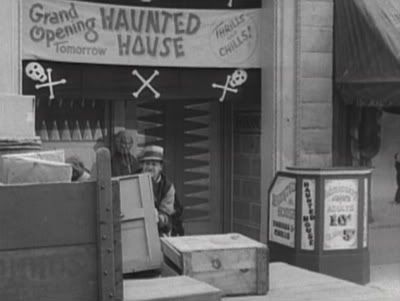
Now the short launches into its second and final act. The kids emerge from the crate scared by the spooky darkness. Alfalfa flips a switch hoping to turn the lights on, but it activates a record with a spooky voice instead. “Many enter this evil house, but few depart alive,” says the voice, menacingly. The great Billy Bletcher is credited with doing voices for this short (I spoke a bit about Bletcher in my review of “Babes in Toyland/March of the Wooden Soldiers” which you can read when you click here).
The voice implores the kids to “choose” a door that will lead to safety or doom. Another reference to “Babes in Toyland/March of the Wooden Soldiers” is made as out of the first door pops a Bogeyman costume, its arms wildly flailing about!
The appearance of the Bogeyman kicks off the obligatory “string of fright gags” the fill many of the short subjects in the “horror-comedy” genre. Here’s an itemized list of the gags that follow:
• Porky and Alfalfa walk through a door marked “EXIT,” where a strange half-giant/half Asian dragon creature billowing smoke from its nostrils yells out “Fee-Fi-Fo-Fum!” The duo try to run away but end up running in place as the floor is really a treadmill.
• Buckwheat sees a fishbowl where the fish’s skeletons are visible through their bodies!
• Sitting down at the bench in front of a pipe organ, Buckwheat is further scared by a skeleton that descends and begins playing a spooky tune on the organ!
• Buckwheat is frozen in fear as a second skeleton descends and places its arm around his shoulder.
• The trio falls through a trap door and down a slide into more dingy darkness.
• The scary voice tells them to sit in a special chair but the kids refuse – until they come face-to-face with a pitchfork-wielding skeleton with Satan’s face as they try to escape!
• Once locked in the seat, it begins to move and the kids face a circular buzz saw spinning right toward their necks!
Of course, all of the above are merely the funhouse attractions of the “Haunted House.” The kids are safely deposited outside where they promptly run back to their headquarters. They find Darla waiting there, who explains that she simply had misplaced the candy.
“Please, don’t ever mention candy or detectives to me again,” exclaims Alfalfa in response as the short sputters to a close.

The gags in this final half of the film are not just literally mechanical, however – in my opinion they are figuratively mechanical, too. The filmmakers seem to just be going through the motions – the gags are lethargic, flat and stilted. What enjoyment is to be had is due to the good will and affection audiences have toward Alfalfa, Buckwheat and Porky from previous films. Likewise, the short gets a tremendous boost from the voice-over involvement of Billy Bletcher.
But this alas is not the kids’ best work, really through no fault of their own. The problem lies with the fact that the “scare comedy” sequence is a result of the very contrivance Leonard Maltin freely acknowledged. In “Spooky Hooky,” the plot hinges on the kids trying to recover their “sick notes” from the dark and scary schoolhouse after hours (they had planned to play hooky but changed their minds once they heard the teacher planned a trip to the circus). You’re more invested in the kids’ quest in “Spooky Hooky” and the predicament that results than you are with “Hide and Shriek”’s detective squad who have merely been deposited into the “haunted house” unwittingly.
In my opinion, “Hide and Shriek” as a whole comes off as a “cut and run” entry done on the fly, with an easy solution being handed to the producers on a plate via the Long Beach pier’s Haunted House attraction. For me, the kids and Bletcher’s frantic vocal delivery elevate it to a half star above average, but it’s a close call. Still, if you enjoy this “gang” of “rascals,” you could do worse than spending ten minutes watching their magnum Roach opus.
BEST DIALOGUE EXCHANGES:
WORKER: Hey, this joint gives me the willies! C’mon, this is no place for us!”
HAUNTED HOUSE PROPRIETOR or JANITOR (see "SPOTTED IN THE CAST" for explanation): “Ha ha ha ha – if you boys want to get the wits scared out of you come out any time!”
ALFALFA: Buckwheat, try that door and see if we can get out.
BUCKWHEAT (shaking his head “no”): Uhn-uh.
ALFALFA: Whatsamatter? You scared?
BUCKWHEAT: A-ha!
DISEMBODIED VOICE: If you want to get out alive sit on that bench!
ALFALFA: Nothing doing, you double-crosser!
BEST GAGS: The aforementioned bits where Alfalfa swears in Porky and Buckwheat as deputies, the nods to “Babes in Toyland/March of the Wooden Soldiers” with the Barnaby disguise and Bogeyman in the haunted house, and Buckwheat’s encounter with skeletons (after all, the pairing of Buckwheat and bones also worked wonders in “Spooky Hooky”).
SPOTTED IN THE CAST: A much bigger mystery than what happened to Darla's candy is the supporting cast of this film. Both Leonard Maltin's book and the Internet Movie Database (imdb.com) list Fred Holmes playing "the janitor." The IMDB website also lists Dick Elliott as playing the "Haunted House Proprietor." The confusion comes from the fact that the fellow who appears to own the haunted house and utter the line, "If you boys want to be scared out of your wits..." doesn't look like Dick Elliott at all and is most likely Fred Holmes. Given this disparity, let's highlight both fine thesps here.
Character actor Dick Elliott is one of those actors who had bit roles in everything from shorts and series entries to feature films, whether prestigious A-films, cheaper B-movies or lower Z-for-zero budget quickies. Some of the classics he appeared in include “It’s a Wonderful Life,” “Mr. Smith Goes to Washington” and “High Noon.” He made appearances in the Edgar Kennedy, Leon Errol and Joe McDoakes shorts. Series entries graced with Elliott’s presence include Mr. Moto, Nancy Drew (in fact, the entry with horror-comedy overtones called “The Hidden Staircase”), Henry Aldrich, Blondie, Boston Blackie, Lone Wolf and Joe Palooka series. When TV came in, he had a recurring role as Officer Murphy on “Dick Tracy” and a few years later as “Mayor Pike” on “The Andy Griffith Show.” He appeared in several different roles in various episodes of “The Lone Ranger,” “I Love Lucy” and “Superman.” On the comedy feature film front, he appeared in a couple of Bob Hope classics (“My Favorite Blonde,” “The Paleface), Wheeler & Woolsey’s “Silly Billies,” the borderline horror-comedy “The Body Disappears” with Edward Everett Horton, the Frankie Darrow-Mantan Moreland starrer “Up in the Air” and several Bowery Boys entries including the “horror-onable mentions,” “Hold That Hypnotist” and “Up in Smoke.” Besides “Hide and Shriek,” the most overt horror-comedy to feature Elliott is the Harry Langdon talkie short, “Shivers.”
Fred Holmes' career was much more brief and seemed to be relegated to play bit parts primarily in Hal Roach-produced shorts and features. Not such a bad gig though as the majority of the time he was either appearing alongside Laurel & Hardy or the Our Gang kids. Holmes appeared with Laurel & Hardy in such classics as "Two Tars," "Wrong Again," "Going Bye Bye," "Babes in Toyland" and "Our Relations." In the Our Gang series Holmes also turned up in "Noisy Noises," "For Pete's Sake," "Beginner's Luck," "Teacher's Beau," "The Lucky Corner" and "Rushin' Balet." He had bits alongside the legend Harold Lloyd in "Hot Water" and was also among the all-star cast of "If I Had a Million," most notable for its sequence with W.C. Fields. Other comedy greats whose films Holmes appeared in include Billy Bevan, Andy Clyde, Vernon Dent, Franklin Pangborn, Arthur Houseman, Patsy Kelly and Thelma Todd.
BUY THE FILM:
“Hide and Shriek” has been released on home video several times. Two of the most recent releases include collections that range from a handful of shorts to a collection containing all the sound shorts originally produced at Hal Roach Studios. Buy them here:
FURTHER READING:
There are two great blogs highlighting the horror comedies of Our Gang/the Little Rascals. Click here to read The Haunted Closet and click here to read Ghosts of Halloween Past.
As for books, the ultimate one on the kids is “Our Gang: the Life & Times of The Little Rascals” by Leonard Maltin. Buy the book here:
WATCH THE FILM:
Nothing beats seeing the short in its entirety with its original soundtrack intact, but if you want to get a taste of the flavor of this short here is an excerpt that was released to the 8mm home movie market in a silent edition with subtitles (8mm and Super 8 were the original “home video” before there was home video – you can read my post about the hobby when you click here). For 8mm home video release, “Hide and Shriek” was renamed “The Haunted House”:

